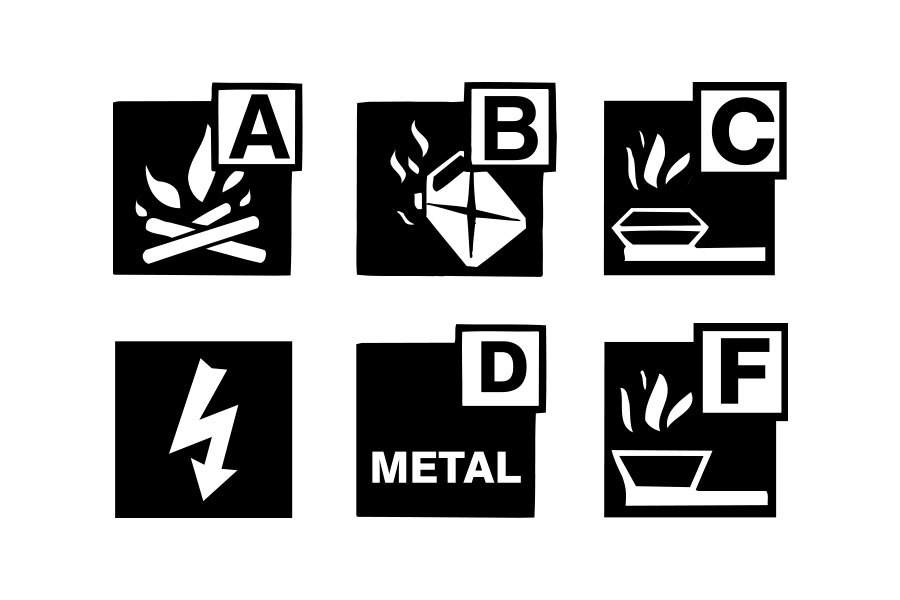Fire Extinguisher Buyers Guide

A buyer’s guide to fire extinguishers
If you’re looking to buy a fire extinguisher, it can be difficult to know where to start. This life-saving piece of equipment can prove critical in the moment – but only if the right one has been installed for the environment.
In this simple guide, we break down the need-to-know information when it comes to fire extinguisher buying. From legal regulations to extinguisher types and contemporary finishes, MG Fire Safety Group covers the basics of these vital pieces of fire safety equipment.
Types of fire and extinguisher
The fire extinguisher you buy will depend entirely on the setting in which you’re installing it. There are six categories of fire and the type of fire extinguisher you require depends on the type of fire that would likely break out in that environment. Class A fires are those whose source is a solid material like wood, paper and textiles, while Class B fires include flammable liquids like petrol and oil. Class C fires are those involving flammable gases like hydrogen or butane. Class F fires are those started by cooking oils – these are usually chip pan fires – and electrical fires are ones started by electrical equipment.
The types of fire extinguisher you’ll need will depend on the type of fire risk in the setting. Water, foam, powder, CO2 and MultiCHEM are among the most effective, high performance extinguishers.
Ratings and sizes
A fire risk assessment will dictate which type of fire extinguisher is needed for your premises – and how many of them are required. Current UK fire regulations state that, unless your premises is extremely small, a minimum of two Class A extinguishers should be installed on each storey of the building. You would need at least two of the following on each floor: three- and six-litre foam extinguishers and nine-litre water extinguishers. If your premises feature a high volume of electrical equipment, CO2 extinguishers would also be required. Regulations state that premises with electrical equipment must feature 2kg CO2 extinguishers. Where there is the presence of 415-volt equipment, 5kg CO2 extinguishers must also be.
Location and installation of fire extinguishers
Ideal siting for fire extinguishers is usually by a fire exit or alarm call point, which are obvious places. British Standards dictates a ’30-metre rule’ in that a person should be no more than 30 metres away from a fire extinguisher wherever they are in the building. The equipment should be clearly visible and signposted with the appropriate fire extinguisher signage. They should be located near potential fire hazards but not so close they can’t be accessed in the event of a fire.
Ensuring the protection of your fire extinguishers is also important - and required by British Standards. Extinguishers should be fixed to the wall or be held in a cabinet or stand to discourage people from moving them and protect against vandalism and accidental damage.
Servicing and replacing fire extinguishers
To comply with British Standards, you must arrange to have your fire extinguishers serviced once a year. Fire Extinguisher Maintenance is extremely important given the potential for equipment to be sat unused for some time. The annual service is carried out by a service engineer but it’s expected that business owners will carry out regular visual checks throughout the rest of the year. Look for telling signs like scratches or rusting that might be an indication the equipment needs a more thorough check.
UK regulations recommend that fire extinguishers are replaced every five years (or every 10 years for CO2 extinguishers). And you must keep a record of all fire extinguisher maintenance, servicing and inspections.
Still not sure which extinguishers are suitable for your premises? Contact Us and we’ll help point you in the right direction.
Where to buy a fire extinguisher
You can buy a fire extinguisher online through a fire extinguisher distributor. This way, you can be confident you’re buying the correct extinguisher and that it meets all the corresponding legal requirements. Buying from some online sites can put you at risk - such as, cheap units are often sold that have expensive spare parts only available through the manufacturer or, that the extinguisher is due for its discharge test, hence sold cheaper.
MG Fire Safety Group provide all suitable fire extinguisher requirements to meet the required British Standards with spare parts readily available for our equipment, yet rarely required.
Further Details - See our info-links below:
1. Fire Risk Assessment - Block of Flats
2. Fire Risk Assessment - House in Multiple Occupation
3. Fire Risk Assessment - Commercial Premises
Our Fire Safety Risk Assessors/ Fire Safety Managers - Manage All Types Of Premises & Building Occupancy Fire Safety.
Contact Us for your legal, cost-effective ex-fire service, Fire Safety Officer Fire Risk Assessment on: 0800 999 8595.
Fire Risk Assessment Slough - Fire Risk Assessment, Fire Risk Assessment Report, Fire Safety Strategy, Fire Safety Consultancy, Fire Extinguisher Service, Fire Warden Training & Fire Evacuation Drills in Slough, Windsor, Taplow, Maidenhead, Bracknell, Heathrow, Uxbridge, Northolt, Harrow, Wembley, Hounslow, Feltham, Brentford, Farnham Common, Gerrards Cross, Bourne End, Marlowe, Beaconsfield & High Wycombe. MG Fire Safety Group is the trading name of Fire Risk Assessment Slough.